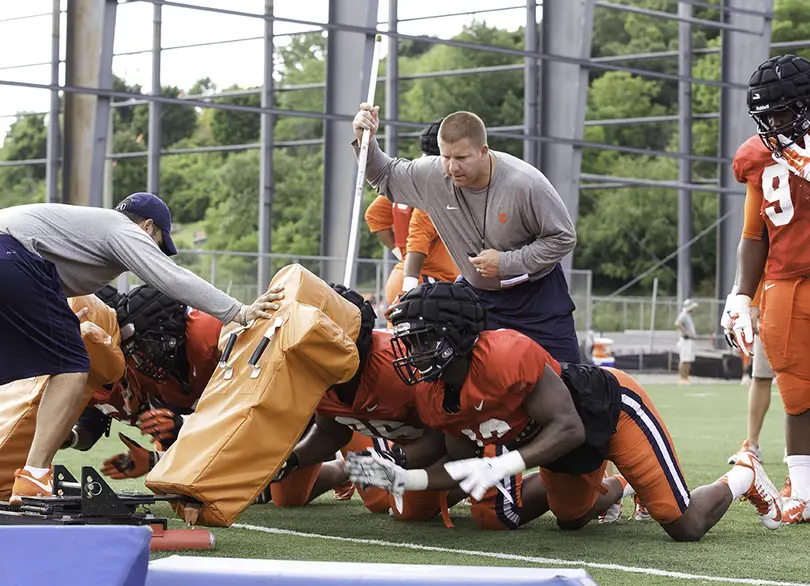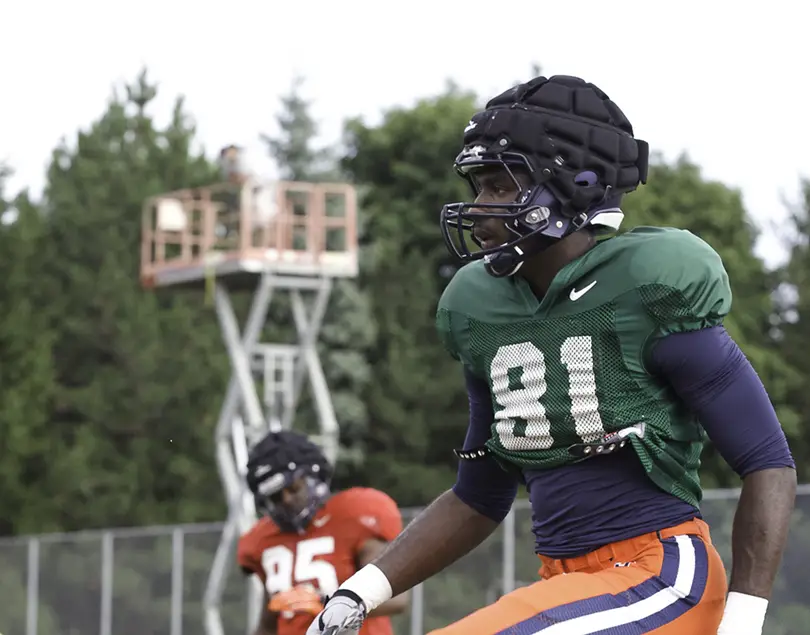Guardian helmet caps help Syracuse practice more safely in 1st year of use after drawing confused initial reactions
The Guardian helmet caps looked weird. They made practice hotter. And the first time Syracuse players saw them in spring practices earlier this year, they were confused.
“I thought they gave our helmet an afro or something,” senior nose tackle Eric Crume said. “I was like, ‘Man, what is that?’
“… The first thing I thought was ‘These summer practices are going to be real hot with these black things on our helmets.’”
They were. But they also absorbed the shock of head-to-head collisions and softened helmet-to-body hits. SU has 80-100 of the soft-shell helmet covers that offensive coordinator Tim Lester helped bring to Syracuse after introducing the product to Elmhurst College in 2012 as the Bluejays’ head coach.
Syracuse is among 12-15 college programs around the country that have purchased the protective foam helmet covers, said Matt Simonds, national sales coordinator for Guardian Caps. When sold in bulk to programs, each cap costs around $45-50, Simonds said. He estimated that SU paid $3,500-$5,000 for its supply of the helmet covers.
“At first I thought they looked a little silly, but they really help and in practice you can definitely tell the difference,” senior wide receiver Jarrod West said.
The Guardian helmet covers amuse Orange players and they left an eerie silence on the practice field the first time SU trained with them. Throughout game days and pre-game warmups, Syracuse players said they feel lighter with the covers off and football hurts a little less now with the caps that are designed to cut down on all injuries, not just to the head. The helmet covers can absorb up to 33 percent of impact, according to the company’s website.
Guardian began pitching the products to the Orange coaching staff in January of 2013 at the American Football Coaches Association conference in Nashville, Tennessee. It started a review process that included conversations with SU’s head football trainer, Denny Kellington and the team’s equipment manager, Jim Schlensker, who ultimately ordered the caps, Simonds said.
“My whole approach there was, ‘Better safe when you have an opportunity to create a more safe environment, why not?’” SU head coach Scott Shafer said.
Throughout his career, he said, “a loud practice meant a physical practice.” On the team’s first day working with the caps, practice was quiet, which for Shafer was strange. The Orange was still having physical practices, but Shafer just didn’t know it until he watched practice film, he said. When he did, he also thought it looked the entire team had afros on their helmets.
The extra material — the caps weigh about seven ounces — slightly slowed the players, but West said he felt less shock in collisions.
And on game days, the players said they feel quicker with the weight removed.
In wearing the caps, Syracuse joins programs like Clemson, Florida, Boston College and Oklahoma, which have all ordered the caps. They’ve been available since 2011 and with Lester since 2012, when he was at Elmhurst.
Though the Guardian caps are approved for high school game use, they aren’t customizable to the point where they could be used in college games. Customizable helmet covers will be available in 12-18 months, Simonds said, but in the meantime they are only available in black, red, silver, gold and what he called “air force” blue and grey.
Said Lynch: “I’ve felt a difference. It feels good. It’s not really more of like a — it prevents concussions, so it’s a good feeling knowing that our heads are protected.”
Published on October 29, 2014 at 12:31 am
Contact Jacob: [email protected] | @Jacob_Klinger_






